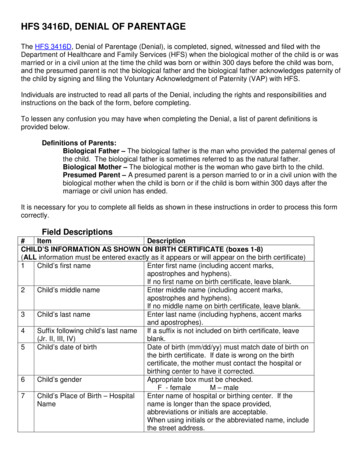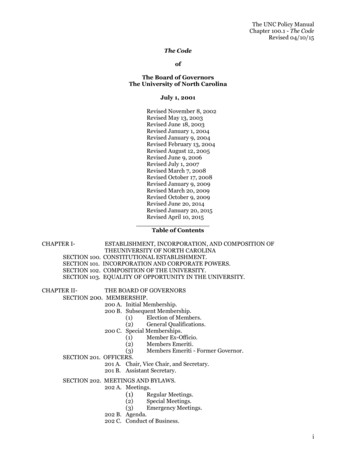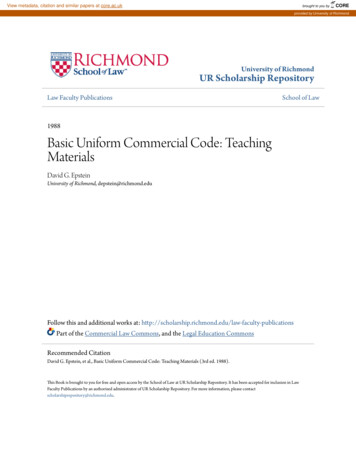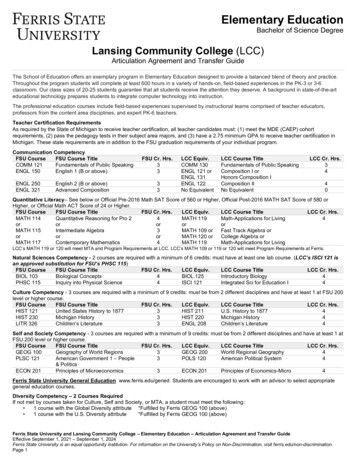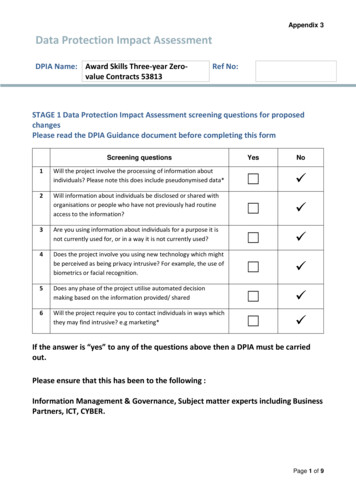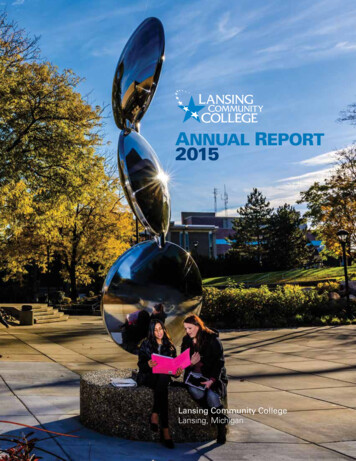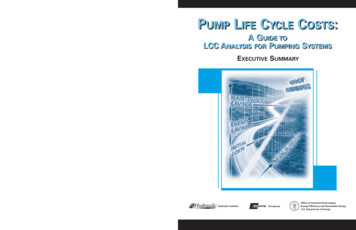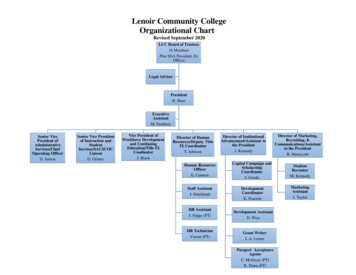
Transcription
DRAFTFOR DISCUSSION ONLYREVISED UNIFORM PARENTAGE ACTNATIONAL CONFERENCE OF COMMISSIONERSON UNIFORM STATE LAWSOctober 28-29, 2016 Drafting Committee MeetingREDLINE DRAFTCopyright 2016ByNATIONAL CONFERENCE OF COMMISSIONERSON UNIFORM STATE LAWSThe ideas and conclusions set forth in this draft, including the proposed statutory language and any comments orreporter s notes, have not been passed upon by the National Conference of Commissioners on Uniform State Lawsor the Drafting Committee. They do not necessarily reflect the views of the Conference and its Commissioners andthe Drafting Committee and its Members and Reporter. Proposed statutory language may not be used to ascertainthe intent or meaning of any promulgated final statutory proposal.October 7, 2016
REVISED UNIFORM PARENTAGE ACTThe Committee appointed by and representing the National Conference of Commissioners onUniform State Laws in preparing this Act consists of the following individuals:JAMIE PEDERSEN, 235 John A. Cherberg Bldg., P.O. Box 40643, Olympia, WA 98504-0643,ChairMELISSA HORTMAN, Minnesota House of Representatives, State Office Building, Room 237,100 Dr. Rev. MLK Jr. Blvd., St. Paul, MN 55155, Vice-ChairMARY M. ACKERLY, 782 Bantam Rd., P.O. Box 815, Bantam, CT 06750-0815BARBARA ATWOOD, University of Arizona, James E. Rogers College of Law, 1201 E.Speedway Blvd., P.O. Box 210176, Tucson, AZ 85721-0176LESLEY E. COHEN, 2657 Windmill Pkwy., #415, Henderson, NV 89074-3384BART M. DAVIS, P.O. Box 50660, Idaho Falls, ID 83405GAIL HAGERTY, Burleigh County Court House, P.O. Box 1013, 514 E. Thayer Ave.,Bismarck, ND 58502-1013KAY P. KINDRED, University of Nevada Las Vegas, William S. Boyd School of Law, 4505 S.Maryland Pkwy., Box 451003, Las Vegas, NV 89154-1003DEBRA LEHRMANN, Supreme Court of Texas, Supreme Court Bldg., 201 W. 14th St., Room104, Austin, TX 78701CLAIRE LEVY, 1395 Kalmia Ave., Boulder, CO 80304DAVID C. McBRIDE, 1000 King St., P.O. Box 391, Wilmington, DE 19899HARRY TINDALL, 1300 Post Oak Blvd., Suite 1550, Houston, TX 77056-3081COURTNEY G. JOSLIN, UC Davis School of Law, 400 Mrak Hall Dr., Davis, CA 95616-5203,ReporterAMERICAN BAR ASSOCIATION ADVISORSTEVEN H. SNYDER, 11270 86th Ave N, Maple Grove, MN 55369-4510, ABA AdvisorMARY L. FELLOWS, P.O. Box 730, Grand Marais, MN 55406, ABA Section AdvisorEX OFFICIORICHARD T. CASSIDY, 100 Main St., P.O. Box 1124, Burlington, VT 05402, PresidentWILLIAM W. BARRETT, 600 N. Emerson Ave., P.O. Box 405, Greenwood, IN 46142,Division ChairEXECUTIVE DIRECTORLIZA KARSAI, 111 N. Wabash Ave., Suite 1010, Chicago, IL 60602, Executive DirectorCopies of this act may be obtained from:NATIONAL CONFERENCE OF COMMISSIONERSON UNIFORM STATE LAWS111 N. Wabash Ave., Suite 1010Chicago, Illinois 60602312/450-6600www.uniformlaws.org
REVISED UNIFORM PARENTAGE ACTPREFATORY NOTE. 1ARTICLE 1GENERAL PROVISIONSSECTION 101.SECTION 102.SECTION 103.SECTION 104.SECTION 105.SECTION 106.SHORT TITLE. . 4DEFINITIONS. . 4SCOPE OF [ACT]; CHOICE OF LAW. . 8COURT OF THIS STATE. 9PROTECTION OF PARTICIPANTS. . 9DETERMINATION OF MATERNITY. . 9ARTICLE 2PARENT-CHILD RELATIONSHIPSECTION 201.SECTION 202.SECTION 203.SECTION 204.ESTABLISHMENT OF PARENT-CHILD RELATIONSHIP. . 10NO DISCRIMINATION BASED ON MARITAL STATUS. . 10CONSEQUENCES OF ESTABLISHMENT OF PARENTAGE. . 11PRESUMPTION OF PARENTAGE. . 11ARTICLE 3VOLUNTARY ACKNOWLEDGMENT OF PATERNITYSECTION 301. ACKNOWLEDGMENT OF PATERNITY. . 15SECTION 302. EXECUTION OF ACKNOWLEDGMENT OF PATERNITY. . 15SECTION 303. DENIAL OF PARENTAGE. . 16SECTION 304. RULES FOR ACKNOWLEDGMENT OF PATERNITY AND DENIAL OFPARENTAGE. . 17SECTION 305. EFFECT OF ACKNOWLEDGMENT OF PATERNITY OR DENIAL OFPARENTAGE. . 18SECTION 306. NO FILING FEE. 18SECTION 307. RATIFICATION BARRED. . 18SECTION 308. PROCEEDING FOR RESCISSION. 18SECTION 309. CHALLENGE AFTER EXPIRATION OF PERIOD FOR RESCISSION. . 19SECTION 310. PROCEDURE FOR RESCISSION OR CHALLENGE. 19SECTION 311. FULL FAITH AND CREDIT. . 20SECTION 312. FORMS FOR ACKNOWLEDGMENT OF PATERNITY AND DENIAL OFPARENTAGE. . 20SECTION 313. RELEASE OF INFORMATION. . 20SECTION 314. ADOPTION OF RULES. . 21
ARTICLE 4REGISTRY OF PATERNITYPART 1GENERAL PROVISIONSSECTION 401. ESTABLISHMENT OF REGISTRY. . 22SECTION 402. REGISTRATION FOR NOTIFICATION. 22SECTION 403. NOTICE OF PROCEEDING. 22SECTION 404. TERMINATION OF PARENTAL RIGHTS: CHILD UNDER ONE YEAR OFAGE. . 23SECTION 405. TERMINATION OF PARENTAL RIGHTS: CHILD AT LEAST ONE YEAROF AGE. . 23PART 2OPERATION OF REGISTRYSECTION 411.SECTION 412.SECTION 413.SECTION 414.SECTION 415.SECTION 416.REQUIRED FORM. . 23FURNISHING OF INFORMATION; CONFIDENTIALITY. . 24PENALTY FOR RELEASING INFORMATION. . 25RESCISSION OF REGISTRATION. 25UNTIMELY REGISTRATION. 25FEES FOR REGISTRY. . 25PART 3SEARCH OF REGISTRIESSECTION 421. SEARCH OF APPROPRIATE REGISTRY. . 26SECTION 422. CERTIFICATE OF SEARCH OF REGISTRY. . 26SECTION 423. ADMISSIBILITY OF REGISTERED INFORMATION. . 27ARTICLE 5GENETIC TESTINGSECTION 501. SCOPE OF ARTICLE. . 27SECTION 502. AUTHORITY TO ORDER OR TO DENY GENETIC TESTING. 27SECTION 503. REQUIREMENTS FOR GENETIC TESTING. . 29SECTION 504. REPORT OF GENETIC TESTING. . 30SECTION 505. GENETIC TESTING RESULTS; CHALLENGE TORESULTS. . 31SECTION 506. COSTS OF GENETIC TESTING. . 32SECTION 507. ADDITIONAL GENETIC TESTING. . 32SECTION 508. GENETIC TESTING WHEN SPECIMENS NOT AVAILABLE. . 33SECTION 509. DECEASED INDIVIDUAL. . 33SECTION 510. IDENTICAL BROTHERS. . 33SECTION 511. CONFIDENTIALITY OF GENETIC TESTING. . 34
ARTICLE 6PROCEEDING TO ADJUDICATE PARENTAGEPART 1NATURE OF PROCEEDINGSECTION 601.SECTION 602.SECTION 603.SECTION 604.SECTION 605.PROCEEDING AUTHORIZED. 35STANDING TO MAINTAIN PROCEEDING. . 35PARTIES TO PROCEEDING. . 37PERSONAL JURISDICTION. . 38VENUE. . 38PART 2SPECIAL RULES FOR PROCEEDING TO ADJUDICATE PARENTAGESECTION 606. NO STATUTE OF LIMITATION: CHILD HAVING NO PRESUMED,ACKNOWLEDGED, OR ADJUDICATED PARENT OTHER THAN THE WOMANWHO GAVE BIRTH. . 39SECTION 607. STATUTE OF LIMITATION: CHILD HAVING PRESUMED PARENT. . 39SECTION 608. STATUTE OF LIMITATION: CHILD HAVING ACKNOWLEDGEDFATHER OR ADJUDICATED PARENT. . 40SECTION 609. GENERAL RULES REGARDING ADMISSIBILITY OF RESULTS OFGENETIC TESTING. . 41SECTION 610. ADJUDICATING PARENTAGE FOR AN INDIVIDUAL WHO IS APARENT UNDER [ARTICLE] 7. . 42SECTION 611. ADJUDICATING PARENTAGE OF A CHILD WITH NO PRESUMEDPARENT. . 42SECTION 612. ADJUDICATING PARENTAGE OF A CHILD WITH ONE OR MOREPRESUMED PARENTS. . 44PART 3HEARINGS AND ADJUDICATIONSECTION 613.SECTION 614.SECTION 615.SECTION 616.SECTION 617.SECTION 618.SECTION 619.SECTION 620.SECTION 621.TEMPORARY ORDER. . 46JOINDER OF PROCEEDINGS. . 46PROCEEDING BEFORE BIRTH. . 47CHILD AS PARTY; REPRESENTATION. . 47JURY PROHIBITED. . 47HEARINGS; INSPECTION OF RECORDS. . 48DISMISSAL FOR WANT OF PROSECUTION. . 48ORDER ADJUDICATING PARENTAGE. . 48BINDING EFFECT OF DETERMINATION OF PARENTAGE. . 49
ARTICLE 7ASSISTED REPRODUCTION OTHER THAN SURROGACYSECTION 701. SCOPE OF ARTICLE. . 51SECTION 702. PARENTAL STATUS OF DONOR. . 51SECTION 703. PARENTAGE OF CHILD OF ASSISTED REPRODUCTION. . 51SECTION 704. CONSENT TO ASSISTED REPRODUCTION. . 51SECTION 705. LIMITATION ON SPOUSE’S DISPUTE OF PARENTAGE. 51SECTION 706. EFFECT OF DISSOLUTION OF MARRIAGE OR WITHDRAWAL OFCONSENT. . 52SECTION 707. PARENTAL STATUS OF DECEASED INDIVIDUAL. . 52ARTICLE 8SURROGACY AGREEMENTSPART 1GENERAL REQUIREMENTSSECTION 801. ELIGIBILITY TO ENTER A GESTATIONAL OR GENETIC SURROGACYAGREEMENT. . 54SECTION 802. REQUIREMENTS OF A GESTATIONAL OR GENETIC SURROGACYAGREEMENT: PROCESS. . 55SECTION 803. REQUIREMENTS OF A GESTATIONAL OR GENETIC SURROGACYAGREEMENT: CONTENT. . 56SECTION 804. SURROGACY AGREEMENT: EFFECT OF SUBSEQUENT CHANGE OFMARITAL STATUS. . 57SECTION 805. INSPECTION OF RECORDS. . 58SECTION 806. EXCLUSIVE, CONTINUING JURISDICTION. . 58PART 2SPECIAL RULES FOR GESTATIONAL SURROGACY AGREEMENTSSECTION 807. TERMINATION OF A GESTATIONAL SURROGACY AGREEMENT. . 58SECTION 808. PARENTAGE UNDER GESTATIONAL SURROGACY AGREEMENT. . 59SECTION 809. GESTATIONAL SURROGACY AGREEMENT: ORDER OFPARENTAGE. . 60SECTION 810. EFFECT OF UNENFORCEABLE GESTATIONAL SURROGACYAGREEMENT. . 61PART 3SPECIAL RULES FOR GENETIC SURROGACY AGREEMENTSSECTION 811. REQUIREMENTS OF PETITION TO VALIDATE A GENETICSURROGACY AGREEMENT. . 62SECTION 812. TERMINATION OF GENETIC SURROGACY AGREEMENT. . 62
SECTION 813. PARENTAGE UNDER VALIDATED GENETIC SURROGACYAGREEMENT. . 63SECTION 814. EFFECT OF NONVALIDATED GENETIC SURROGACY AGREEMENT. 65ARTICLE 9IDENTIFYING INFORMATION ABOUT DONORSSECTION 901.SECTION 902.SECTION 903.SECTION 904.SECTION 905.PROSPECTIVE EFFECT ONLY. 66COLLECTION OF IDENTIFYING INFORMATION. . 66AFFIDAVITS REGARDING DISCLOSURE. . 66DISCLOSURE OF IDENTIFYING INFORMATION. . 67RECORD KEEPING. . 67ARTICLE 10MISCELLANEOUS PROVISIONSSECTION 1001.SECTION 1002.SECTION 1003.SECTION 1004.SECTION 1005.UNIFORMITY OF APPLICATION AND CONSTRUCTION. 68TRANSITIONAL PROVISION. . 68SEVERABILITY CLAUSE. . 68REPEAL. 68TIME OF TAKING EFFECT. . 68APPENDIXFEDERAL IV-D STATUTE RELATING TO PARENTAGE . 69
0313233343536373839404142434445REVISED UNIFORM PARENTAGE ACTDrafted by:National Conference of Commissioners on Uniform State Laws (NCCUSL)111 N. Wabash Avenue, Suite 1010, Chicago, IL 60602312-450-6600, www.uniformlaws.orgBrief description of act:The Uniform Parentage Act (UPA) was originally promulgated in 1973 (1973 UPA). The 1973UPA removed the legal status of illegitimacy and provided a series of presumptions used todetermine a child’s legal parentage. A core principle of the 1973 UPA was to ensure that “allchildren and all parents have equal rights with respect to each other,” regardless of the maritalstatus of their parents. 1973 UPA, Section 2, Comment.The UPA was revised in 2002 (UPA 2002). The 2002 UPA augmented and streamlined theoriginal 1973 UPA. The 2002 UPA added provisions permitting a non-judicial acknowledgmentof paternity procedure that is the equivalent of an adjudication of parentage in a court and addeda paternity registry. The 2002 UPA also included provisions governing genetic testing and rulesfor determining the parentage of children whose conception was not the result of sexualintercourse. Finally, the 2002 UPA included a bracketed Article 8 that authorizes surrogacyagreements.4647The 2017 UPA revises the Act to address three primary issues. First, the 2017 UPA seeks toensure the equal treatment of children born to same-sex couples. The 2002 UPA is written ingendered terms, and its provisions presume that couples consist of one man and one woman. Forexample, Section 703 of the 2002 UPA provides that “[a] man who provides sperm for, orconsents to, assisted reproduction by a woman as provided in Section 704 with the intent to bethe parent of her child, is a parent of the resulting child.”In its 2015 decision in Obergefell v. Hodges, 135 S. Ct. 2584 (2015), the United States SupremeCourt held that laws barring marriage between two people of the same sex are unconstitutional.After Obergefell, some parentage laws that treat same-sex couples differently than different-sexcouples may be unconstitutional. For example, in July 2015, a federal district court in Utah heldthat refusing to apply Utah’s assisted reproduction parentage provisions equally to same-sexcouples likely was unconstitutional. Under the Utah Uniform Parentage Act, which is modeledon the 2002 UPA, a husband who consents to his wife’s insemination is the legal father of theresulting child. Utah Code Ann. §§ 78B-15-703, 78B-15-704; 78B-15-201(2)(e). The courtconcluded that the plaintiffs were “highly likely to succeed in their claim” that extending the“benefits of the assisted reproduction statutes to male spouses in opposite-sex couples but not forfemale spouses in same-sex couples” was unconstitutional. Roe v. Patton, 2015 WL 4476734, *3(D. Utah. 2015). The 2017 UPA updates the Act to address this potential constitutional infirmityby amending the provisions so that they address and apply equally to same-sex couples.Second, the 2017 UPA updates the surrogacy provisions to reflect developments in that area.States have been particularly slow to enact Article 8 of the 2002 UPA. Eleven (11) states adopted1Deleted: amendedDeleted: updates
031323334353637383940versions of the 2002 UPA.1 Of these eleven (11) states, only two (2) – Texas and Utah – enactedthe surrogacy provisions based on Article 8 of the 2002 UPA. At least five (5) of the eleven (11)states that enacted the 2002 UPA enacted surrogacy provisions that are not premised on the 2002UPA. These states include: Delaware (permitting) (enacted 2013); Illinois (permitting) (enacted2004); Maine (permitting) (enacted 2015); North Dakota (banning) (enacted 2005); andWashington (banning compensated) (enacted 1989).The fact that very few states enacted Article 8 is likely the result of a confluence of factors. Onelikely factor is the controversial nature of surrogacy itself. But the fact that four of the states thatenacted the 2002 UPA have provisions permitting surrogacy that are not modeled on Article 8 ofthe 2002 UPA suggests that the small number of enactments is also affected by the substance ofArticle 8. Accordingly, the 2017 UPA updates the surrogacy provisions to make them moreconsistent with current surrogacy practice.Finally, the 2017 UPA includes a new article – Article 9 – that addresses the right of childrenborn through assisted reproductive technology to access medical and identifying informationregarding any gamete providers. Based on data from 2014, the CDC reports that “approximately1.6% of all infants born in the United States every year are conceived using ART.”2 Data suggestthat this percentage continues to increase. Gaia Bernstein, Unintended Consequences:Prohibitions on Gamete Donor Anonymity and the Fragile Practice of Surrogacy, 10 Ind. HealthL. Rev. 291, 298 (2013) (noting that “from 2004 to 2008 the number of IVF cycles used forgestational surrogacy grew by 60%, the number of births by gestational surrogates grew by 53%and the number of babies born to gestational surrogates grew by 89%”). Accordingly, it isincreasingly important for states to address the right of children to access information about theirgamete donor. Article 9 does not require disclosure of the identity of gamete providers, but itdoes require gamete banks and fertility clinics to ask donors if they want to have their identifyinginformation disclosed when the resulting child turns 18.Questions about UPA?For further information contact the following persons:Jamie Pedersen, Chair of the UPA drafting committeeCourtney G. Joslin, Reporter for the UPA drafting committeeNotes about ULC Acts:For information on the specific drafting rules used by ULC, the Conference Procedural andDrafting Manual is available online at www.uniformlaws.org.Because these are uniform acts, it is important to keep the numbering sequence intact whiledrafting.1The eleven states are: Alabama, Delaware, Illinois, Maine, New Mexico, North Dakota,Oklahoma, Texas, Utah, Washington, Wyoming. See Uniform Law Commission, LegislativeFact Sheet – Parentage Act.2Centers for Disease Control, ART Success Rates, http://www.cdc.gov/art/reports/ (last updatedFebruary 24, 2016).241424344454647484950515253545556Deleted: Only limited amendments were made to Articles1-5. Accordingly, Articles 1-5 are presented in amendmentform, and changes to Articles 1-5 are reflected in strike andunderscore. More substantial changes were made to Articles6-10. As a result, reading Articles 6-10 in amendment formproved difficult. Accordingly, the Drafting Committeedecided that these articles should be presented in revisionform. The Drafting Committee did, however, created acomparison document that shows the changes to Articles 610. On June 2, 2016, the Scope and Program Committeeapproved the submission of the Act in a hybridamendment/revision format and approved the ability of theDrafting Committee to make nonsubstantive, structuralchanges to the Act. On June 10, 2016, the ExecutiveCommittee approved these requests.¶¶
1234567891011121314In general, the use of bracketed language in ULC acts indicates that a choice must be madebetween alternate bracketed language, or that specific language must be inserted into the emptybrackets. For example: “An athlete agent who violates Section 14 is guilty of a [misdemeanor][felony] and, upon conviction, is punishable by [].A word, number, or phrase, or even an entire section, may be placed in brackets to indicate thatthe bracketed language is suggested but may be changed to conform to state usage orrequirements, or to indicate that the entire section is optional. For example: “An applicant forregistration shall submit an application for registration to the [Secretary of State] in a formprescribed by the [Secretary of State]. [An application filed under this section is a publicrecord.] The application must be in the name of an individual, and, except as otherwise providedin subsection (b), signed or otherwise authenticated by the applicant under penalty of perjury.”The sponsor may need to be consulted when dealing with bracketed language.3
1REVISED UNIFORM PARENTAGE ACT2ARTICLE 13GENERAL PROVISIONS4567891011A word about a drafting convention of the Conference that appears throughout this Act. Bracketsin the statutory text are inserted to warn legislative draftsmen in the several states that thesuggested language is likely to be subject to local variation. For example, a state may not referto UPA (2017) as an “[act],” but may label it as a “chapter,”, “title,” etc. Often times thebrackets flag terminology that is known to vary greatly, e.g., [petition], or is clearly subject tolocal option, e.g., [30 days].12Parentage Act.SECTION 101. SHORT TITLE. This [act] may be cited as the Revised Uniform13SECTION 102. DEFINITIONS. In this [act]14(1) “Acknowledged father” means a man who has established a father-child relationship15161718under [Article] 3.(2) “Adjudicated parent” means an individual who has been adjudicated by a court ofcompetent jurisdiction to be the parent of a child.(3) “Alleged father” means a man who alleges himself to be, or is alleged to be, the19genetic father or a possible genetic father of a child, but whose paternity has not been20determined. The term does not include:21(A) a presumed father;22(B) a man whose parental rights have been terminated or declared not to exist; or23(C) a male donor.2425(4) “Assisted reproduction” means a method of causing pregnancy other than sexualintercourse. The term includes:26(A) intrauterine insemination;27(B) donation of eggs;4
1(C) donation of embryos;2(D) in-vitro fertilization and transfer of embryos; and3(E) intracytoplasmic sperm injection.(5) “Child” means an individual of any age whose parentage may be determined under45(6) “De facto parent” means an individual with an unrebutted presumption of parentage67established under Section 204(a)(6) of this [act].(7) “Determination of parentage” means the establishment of the parent-child relationship8910by the signing of a valid acknowledgment of paternity under [Article] 3 or adjudication by thecourt.11(8) “Donor” means an individual who produces gametes used for assisted reproduction,12whether or not for consideration, unless the individual and the woman giving birth enter into a13writing providing to the contrary. The term does not include:1415Deleted: ¶(6) “Commence” means to file the initial pleading seekingan adjudication of parentage in [the appropriate court] of thisstate.282930313233Deleted: ; or¶(C) an individual who provides gametes for use inassisted reproduction where the individual and the womangiving birth both consent to the use of assisted reproductionwith the intent that the individual will be the parent of theresulting child.except as otherwise provided in [Article] 8]; or(B) a parent under [Article] 7 [or an intended parent under [Article] 8].17(9) “Ethnic or racial group” means, for purposes of genetic testing, a recognized group18that an individual identifies as all or part of the individual’s ancestry or that is so identified by19other information.(10) “Genetic testing” means an analysis of genetic markers to exclude or identify a man21as the genetic father or a woman as the genetic mother of a child. The term includes an analysis22of one or a combination of the following:2324252627(A) a woman who gives birth to a child by means of assisted reproduction [,1620Commented [JDP1]: Guida (RI) suggests adding thefollowing to the end of the definition: “and to the extent thatthere is more than one (1) child resulting from any singlepregnancy that is the subject of this act, the duties andresponsibilities of the parent, intended parent, and surrogateset forth in this act shall extend to each such child resultingfrom such single pregnancy.”CJ: I don’t think that is necessary. The usual rules ofstatutory construction require the singular to include theplural.this [act].(A) deoxyribonucleic acid; and5
123(B) blood-group antigens, red-cell antigens, human-leukocyte antigens, serumenzymes, serum proteins, or red-cell enzymes.[(11) “Genetic surrogate” means an adult woman who is not an intended parent and who4agrees to become pregnant through assisted reproduction using her own gamete, pursuant to a5genetic surrogacy agreement as set forth in [Article] 8.]6[(12) “Gestational surrogate” means an adult woman who is not an intended parent and7who agrees to become pregnant through assisted reproduction using gametes that are not her8own, pursuant to a gestational surrogacy agreement as set forth in [Article] 8.]9(13) “Identifying information” includes the following information of the donor:10(A) the first and last name of the individual; and11(B) the age of the individual at the time of donation.12(14) “Individual” means a natural person of any age.13(15) “Individual with a claim to parentage” means any individual who has a claim to be14adjudicated a parent under this [act], but who has not yet been adjudicated to be a parent and15who is not a parent as a matter of law under the [act]. The term includes presumed parents and16individuals identified as genetic parents under Section 505.1718(16) “Intended parent” means an individual, married or unmarried, who manifests theintent to be legally bound as the parent of a child resulting from assisted reproduction.19(17) “Man” means a male individual of any age.20(18) “Parent” means an individual who has established a parent-child relationship under212223Commented [CJ3]: Cutrona (DE) asks wonders whetherthis term should be gender neutral.Section 201.(19) “Parent-child relationship” means the legal relationship between a child and a parentof the child. The term includes the mother-child relationship and the father-child relationship.6Commented [CJ4]: Behr (AK).24Deleted: “Individual with a claim to parentage”Commented [CJ6]: CJ: This definition may need to berevisited after a decision is made about numerosity. If a childcan have more than two legal parents, then this definitionmay need to include people who are parents
section 311. full faith and credit. 20 section 312. forms for acknowledgment of paternity and denial of . section 609. general rules regarding admissibility of results of . limitation on spouse's dispute of parentage. 51 section 706. .
